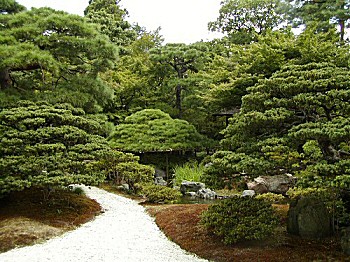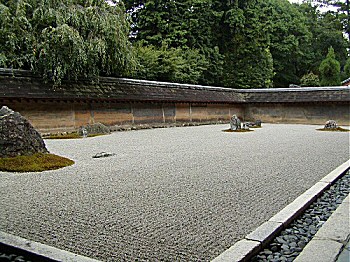Message
Tea History
Japanese Tea History
Interest in the Japanese culture (together with respect and often some perplexity) arose in Russia after the Russo-Japanese War (1904-1905). This interest has wonderfully developed over the past century — one can remember Alexander Nevsky, whose books are still used by Japanese students, and hazardous Far-Eastern crab-catching, and Tom Cruise, who is not the last samurai, as it appeared. |
||
| Japanese Garden. | ||
But undoubtedly, the Japanese tea ceremony raises the most respectful perplexity. Even the habit to cut off one’s finger phalanges at trifles, open one’s belly, and committing seppuku at some serious troubles, are closer to us in spirit than to enjoy sitting for two hours on one’s knees in a scantily lit room, waiting for tea of doubtful taste. I shall tell you about this sitting-waiting ceremony in more details a bit later. This time, I shall speak the Japanese tea history.
The Japanese tea history is not so much the state of affairs as the story of people — monks, samurai, literary men, whose life was connected with tea. Whether this connection was constant or sporadic is of no importance. Treating every tea as the last and best one in their life, these people brought about such a subtle perception and such strong emotions to the tea tradition that one cannot but kneel on the threshold of their tea room…
Tea was brought into Japan twice, both times from China, and both times by Buddhist monks. Nothing but memory remained of the first ‘supply’ (805, brought by Saicho). Most probably the tea seeds and skills of tea drinking brought by the monk did not root. The second coming of tea to Japan (1191, Eisai) turned out a success. Monks appreciated both healing and mystical qualities of the drink and started using tea to support their both physical and spiritual strengths. By the way, Eisai happened to be in China when powdered green tea was prevailing there — this kind of tea became the basis of the Japanese tea tradition.
Tea came to life of Japanese aristocracy together with Buddhism. But in aristocratic surroundings tea drinking exceeded the limits of a religious ritual. Over several centuries (12th to 16th) aristocratic tea drinking had become an art full of complexities, stylizations, and a secret but easy-to-guess philosophic meaning. Tea tournaments were of great popularity at that time, where different teas were served to guests, who were to make out the variety of tea and the place where it was cultivated.
 |
||
| Zen Garden of Stones. | ||
Tea accessories became a cult: specially trained experts selected them, they could be a gift to redeem any fault, and there is a story of a samurai who broke his favorite tea bowl before committing seppuku — so that the enemy would not get it. A new tea ceremony, called ‘rinkan’, got spread; during the ceremony tea was drunk while taking a bath.
In brief, all these tea luxuries exasperated Japanese public opinion. Citizens and peasants, supported by progressive clergymen, not only organized several large-scale riots but also laid foundation of new tea aesthetics.
One of the founders of this aesthetics was Murata Shuko. At the close of the 15th century Murata develops Chanoyu (‘hot water for tea’) — a Japanese tea ceremony based on principles of naturalness and simplicity. Sen Rikyu was the one who brought the ceremony to perfection.
Sen Rikyu (1520—1591) is still considered the greatest tea master of Japan — the ‘golden tea room’, which he built, is regarded a model tea room, and the suicide he committed is penetrated with tragic aesthetics peculiar to the age of samurai. Sen Rikyu was one of the organizers of Kitano Shrine Great Tea Gathering (Oct., 1587) made by Hideyoshi (a military leader who accomplished the union of Japan). Five thousand people took part in the ceremony — and this great event became a swan song of aristocratic tea drinking in Japan. According to one of the versions, Sen Rikyu committed suicide as a protest — so much all that was happening was against his aesthetic principles. But since the Gathering took place four years before Rikyu actually claimed his own life, most probably, it is but a beautiful legend…
Sen Rikyu’s descendants continued his work. Great-grandsons with names funny for our — Russian — ear (Sen Sosa, Sen Soshu, and Sen Soshitsu) created three tea schools, which exist even nowadays. In Moscow, there is an office of one of them (Urasenke).
Since the middle of the 19th century the Japanese have been trying to adapt their tea tradition to Western culture and at the same time to explain to us the secret meaning of the Japanese tea aesthetics. In 1911, in New York, ‘The Book of Tea’ by Okakuro Kakusô was published. The book, which aimed at communicating eastern aesthetics to western readers, produced a strange effect — it began to be cited as an example of Japanese oddities.
Speaking about the Japanese tea history, one can also mention Yasunari Kawabata, who revealed the soul of Japan and the Japanese tea ceremony to the Western World, got a Nobel Prize for his ‘Thousand Cranes’, and committed suicide in 1972. But this is not a tea story already…
That is all. Just one more remark: in Japan, they drink not only powdered tea and do it not only through tea ceremonies.
Denis Shumakov